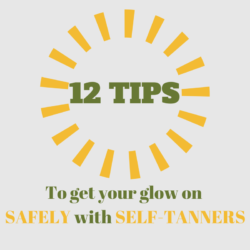12 Self-Tanner Tips That Will Provide You with a Safe(r) Glow

 It’s freezing out. We’re in the midst of the bitterly cold winter months here in the Northeast. While many of us are thinking about warmer, sunnier days, the reality is we’ve got a ways to do before we get back to that… One thing that coincides with warmer months is tan skin. And while we shy away from the subject due to the health risks it imparts with regard to our skin, the truth is there are a lot of people out there that like to chase that bronzed look. So, we thought we’d revisit an old blog our colleague, Dr. Robin Travers (who serves on our Medical Advisory Board) wrote for her practice’s blog, SkinCare Physicians – longtime supporters of us here at IMPACT Melanoma.
It’s freezing out. We’re in the midst of the bitterly cold winter months here in the Northeast. While many of us are thinking about warmer, sunnier days, the reality is we’ve got a ways to do before we get back to that… One thing that coincides with warmer months is tan skin. And while we shy away from the subject due to the health risks it imparts with regard to our skin, the truth is there are a lot of people out there that like to chase that bronzed look. So, we thought we’d revisit an old blog our colleague, Dr. Robin Travers (who serves on our Medical Advisory Board) wrote for her practice’s blog, SkinCare Physicians – longtime supporters of us here at IMPACT Melanoma.
So without further ado, let’s dive in:
“Many patients at SkinCare Physicians want the “healthy” bronze of a tan—but without the risks associated with ultraviolet light exposure. Here is what our dermatologists have to say about self-tanners’ safety and how to best apply them.
What’s in your self-tanners?
Most self-tanners contain very safe ingredients, either dihydroxyacentone (DHA) or erythrulose. DHA is a type of sugar molecule that turns brown when it reacts with amino acids in your skin surface, in a reaction similar to that of an apple turning brown when exposed to the air. The browning with DHA occurs fairly swiftly, but erythrulose takes longer to take effect. The 2 ingredients together may be less drying and may take longer to fade.
Self-tanning tips to get your glow on safely with self-tanners!
- Practice, practice, practice. No matter how much you plan out your self-tanning strategy, practice makes perfect. Don’t attempt to use a self-tanner on the day of a big event, where streaky, haphazard application mistakes will be made obvious. Practice on a cold, rainy day when you know that any mistakes can be hidden and evened out. You’ll become a pro at quick, even application of self-tanners when it matters most!
- Keep your skin self-tanner-ready on a regular basis. Exfoliate gently in the shower (especially elbows, knees, and bony areas of wrists and ankles, which tend to over-absorb self-tanners) and apply moisturizers daily. Moisturizers with “keratolytic” agents like lactic acid, glycolic acid, or salicylic acid help keep your skin smooth and ready to prepare your skin for smooth self-tan application. Retinoids on your face at night serve the dual purpose of preventing photoaging, as well as keeping your skin smooth and ready for self-tanner.
- Do your self-tanning after everything else. Get your manicure, hair coloring, and waxing done before your self-tanning session. Especially if your skin tends to get irritated after shaving or waxing, let the irritation subside fully before applying self-tanner.
- Apply self-tanner after a shower, but be sure to thoroughly dry your skin and wait 10 minutes before self-tanner application.
- Avoid moisturizers for the most part this one time, because the oils can result in uneven absorption of the self-tanner! A few spots could use a little moisturizer, though, to dilute the product: apply lotion to joints like the elbows, knees, bony areas of the wrist and ankle, and atop your knuckles. A light application of lotion here will prevent these thick-skinned spots from saturating with self-tanner and turning overly dark.
- Start from your feet and work your way up, applying the self-tanner to small areas at a time. Avoid bending at the waist while the self-tanner is still damp, to avoid streaking at the crease of your waist. Tan your arms last, also to avoid having to bend too much while the tanner is damp and can be smudged into the crook of your arm.
- Use a spray tanner to reach your back, or consider investing in lotion applicator (sort of like a sponge at the end of a wooden handle) to ensure even application there.
- Go easy on your face, and consider using a gradual build-a-tan formulation there to ensure an even look.
- Some people like to wear rubber gloves to apply their self-tanners. If you opt not to, be sure to wash your hands immediately after self-tanner application. Keep a warm, damp face cloth handy to wipe your palms on immediately after self-tanner application to avoid dark-orange skin there! A nail brush or nail polish remover pads will help clear your cuticles and nails of excess self-tanner.
- Have a good book ready or the next episode of the binge-watching television of your choice. It’s essential to give the self-tanner adequate drying time before putting on clothing. Letting the self-tanner dry even longer than the label might suggest will help you achieve that natural, even glow. If you MUST speed up the process, using a hair dryer on the “cool” setting may get you on your way a bit more quickly.
- Keep your tan even over the following week by using gentle cleansers in the shower, and avoiding tight jeans or leggings . Moisturizing immediately after your shower will help you avoid that “alligator look” as the self-tanner fades. A gentle exfoliation 3-4 days after your self-tanning session will help your skin slough evenly for more natural fading.
- Wear your sunscreen! You may look tanned, but your “faux glow” doesn’t typically offer sun protection. Be sure to apply a broad-spectrum, water-resistant sunscreen daily with an SPF 30+.
Remember to practice these self-tanning tips to get a safe glow while protecting yourself from the sun!”
For more information on SkinCare Physicians, visit www.skincarephysicians.net.

